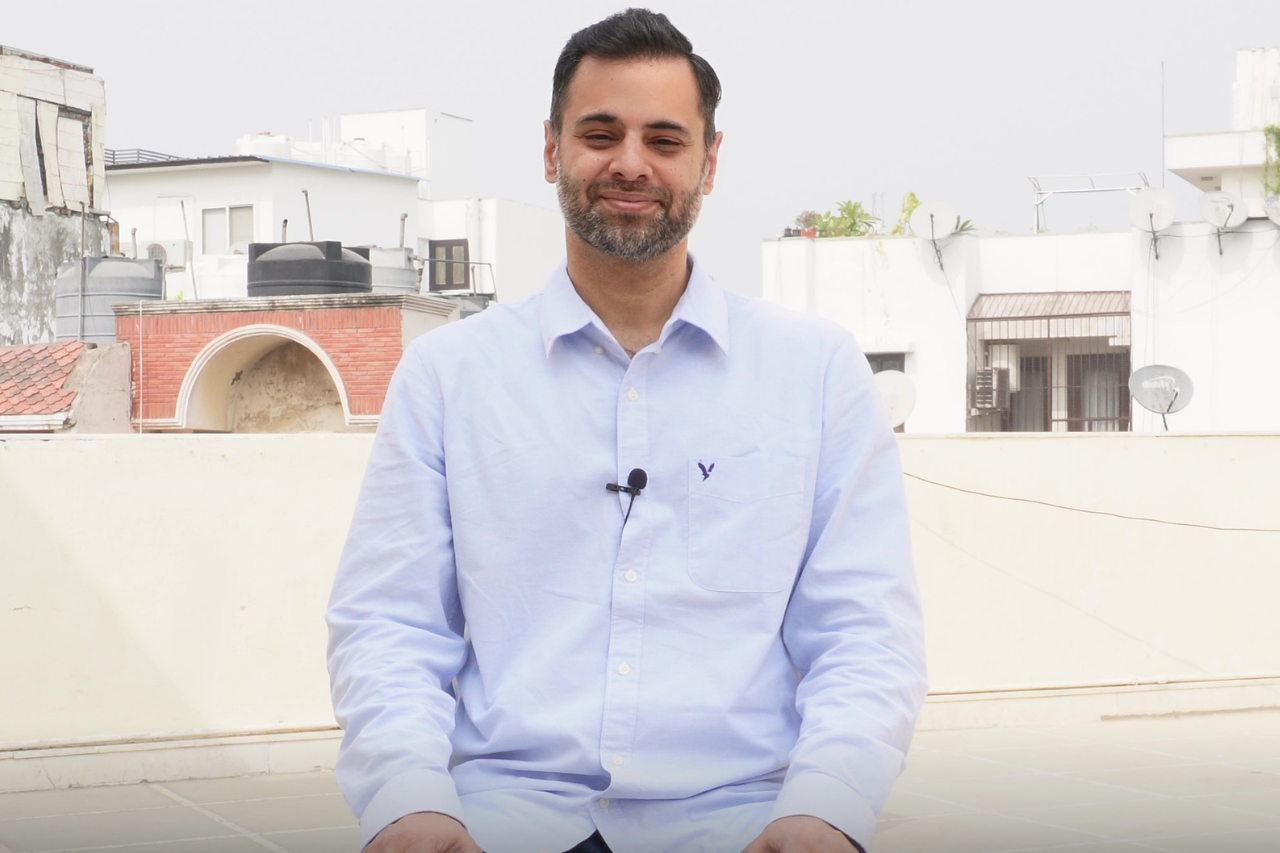Up to this point in our quest for mindfulness, we explored what meditation is and the benefits it offers. However, we never got into the scientific aspect of it. In this article, we will dive a little deep and understand what happens inside our brains when we meditate.
The brain is the most complex organ of the human body and has been the subject of study in the scientific community for many ages. The brain is the CPU of the entire body, and it’s essential to understand what goes on inside of it.
Before we go deep into what brainwaves are and how to use them to our advantage, we must remember that this is a relatively new area of research.
Although neuroscientists have been studying the brain for ages, it’s only recently that we have made breakthroughs and came to know about how brain activity affects our thinking and emotions.
Modern science has also established the fact that meditation greatly affects electrical activity going on within the brain.
As meditation is something you can do anytime and anyplace, you can have access to the part of your brain that dictates emotions.
With this knowledge, you can bio-hack your way to unlimited joy and beat stress and anxiety for good. All of this can be done without you spending too much money and from the comfort of your own home.
What are Brain Waves?
Our brain is composed of billions of neurons where each neuron connects to many other neurons in the brain. Whenever we perform cognitive activities such as thinking, reasoning, perceiving, or decision-making, the corresponding group of neurons are lit up inside the brain, i.e. electrical signals pass back and forth between them.
For example, when you drive to work, you don’t have to think about the route every time because your brain is intelligent enough to light up the corresponding neurons in the brain that tells you where to go.
By repeating an action over and over again, we train our neurons to behave in a particular manner. Our brain learns to activate the right group of neurons in different situations.
When these neuron cells are active they pass electric pulses back and forth and send messages to each other. The network of cells synchronizes their firing and this becomes a repeating cycle known as the “brainwave”.
Brainwaves, also known as neural oscillations, are the way scientists measure the functioning of the brain. This electrical activity within the brain is quite strong and is measured by an instrument called EEG (electroencephalogram).
In this technique, electrodes are placed on top of the scalp where they detect the electrical pulses with the help of EEG. These electrical pulses are further visually analyzed on a display monitor. This technique is known as Electroencephalography.
So the next question is – how are these brain waves measured? They are measured as the number of times the neurons are firing (cycles) electric pulses per second. These cycles (also known as frequencies) are measured in Hertz, or Hz in short.
Brain waves with lower frequencies make us feel tired and sluggish, whereas brain waves with higher frequencies correspond to more alertness and awareness.
Primarily, there are 5 types of brain waves:
- Delta Brainwaves (0.1 – 4Hz)
- Theta Brainwaves (4 – 7Hz)
- Alpha Brainwaves (7 – 13Hz)
- Beta Brainwaves (12 – 30Hz)
- Gamma Brainwaves (32 – 100Hz)
Delta Brainwaves (0.1 – 4Hz)
These are the brainwaves you produce when you are in a state of deep rest or sleep. Delta brainwaves are the most mysterious of all brainwaves. During the delta cycle, we are in the deepest part of our sleep, so much so, that we don’t even experience any dream in this state.
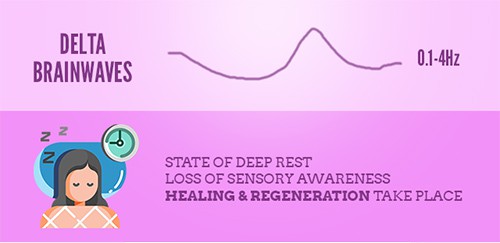
It’s hard to remain conscious in this state. My own take on this is that consciousness does not disappear in this state. It’s just that there is nothing to be aware of because our brain changes activities in the regions that correspond to sensory inputs.
Delta brainwaves are predominant in children up to the age of 1 year (just an estimate – this is subjective). They are also the last brainwaves to be produced before we die.
Zen masters and monks are said to emit delta waves during deep meditative states. In this state, there is no awareness of what is happening, but the body goes through a period of healing and regeneration.
Some experienced meditators are able to achieve this state of deep rest within a short time (within an hour or two), as compared to what regular people experience after a deep sleep of eight hours.
Theta Brainwaves (4 – 7Hz)
These are associated with deep meditation, and expert meditators are said to have experienced this state, which gives deep relaxation and dream-like imageries. Theta waves are associated with daydreaming, enhanced learning, and creativity.
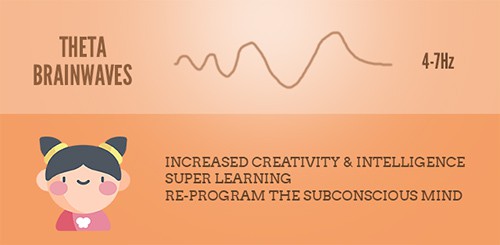
Time spend in theta is associated with deep physical relaxation, imagination, intuition, and emotional connection.
In this state, your imagination runs wild. I’m sure you must have experienced dreams where you craft a story, where you are the center of attraction with remarkable capabilities. And at the same time, you experience emotions in the same way as you would when you’re awake.
Kids spend a lot of time in theta. Their imagination works more than adults. That’s why kids are fast learners. Theta state is associated with super-learning.
They are not afraid to experiment and are open to all ideas, unlike adults who filter out information based on past experiences. There is no judgment in the theta state.
Have you ever wondered “what thinking outside the box” means?
Thinking outside the box happens when your logical mind does not put constraints on your thinking. It happens when you stop judging the contents of your mind and start accepting everything. Theta brainwaves facilities this kind of thinking.
Theta waves give you the idea that “this is possible and it can happen” after that your logical mind (in beta state) takes over and helps you to turn that thought into reality.
In fact, the theta state can help you to re-program your subconscious mind by storing information in long-term memory. The dreams experienced in heightened theta state are remembered for a long period of time (potentially many years or even a lifetime).
Alpha Brainwaves (7 – 13Hz)
Alpha brainwaves are associated with calmness and alertness where the mind and body are in sync with each other. Alpha state is all about the ‘now’ or the present moment.
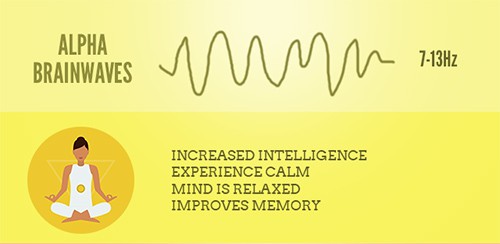
When you are in the beginning phase of your meditation, you transition from beta to alpha. As a result, you start experiencing more calm as the mind becomes quieter. Alpha brainwaves calm the overall nervous system and lower the heart rate.
In the alpha state, the mind is clear of unwanted thoughts and the functioning of the senses (inputs) is minimized. This is what is experienced when we start practicing mindfulness.
Mindfulness teaches us to be in the present moment and allow the flow of thoughts in and out of the mind without focusing on any one of them. With the regular practice of mindfulness and meditation, you experience the effect of alpha brainwaves.
The moment you start focusing on thoughts (either in a positive or negative way) you move from alpha to beta.
Alpha brainwaves are linked with a relaxed state of mind; as a result, psychologists use a technique called Biofeedback (a technique used to treat a variety of medical conditions) to treat ailments like stress, depression, and even chronic pain.
By practicing meditation every day, you train your brain to generate alpha brainwaves. However, this will not happen overnight. It takes time and patience.
Some of the benefits associated with alpha brainwaves are as follows:
- Increased creativity and intelligence.
- Improved memory.
- Feeling calm and relaxed.
- High level of alertness.
One of the ways to generate alpha brainwaves is to daydream. People who are addicted to daydreaming use it as a mechanism to overcome stress and depression, which is a result of too much activity going on inside the brain.
However, daydreaming is not the best way to handle this type of situation because it can become addictive and interfere with your daily life.
Beta Brainwaves (12 – 30Hz)
Beta brainwaves are predominant during the normal waking consciousness. Whenever we are engaged in activities like problem-solving, public speaking, or analytical thinking, beta brainwaves are at work. This is the state most people spend time in.
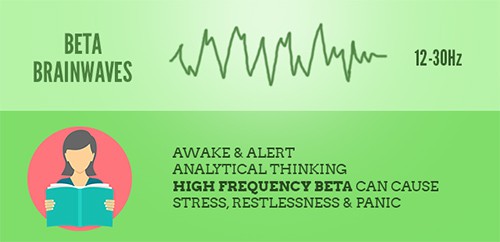
Beta brainwaves can be divided into three parts:
- Low Beta (12-15Hz) – is associated with high concentration and focused mind.
- Mid-Range Beta (15-20Hz) – is associated with increase in energy, stress, and also some anxiety.
- High Beta (20-30Hz) – is associated with high stress, anxiety, restlessness, paranoia, and depression.
In this state, your mind is sharp and completely focused. If you are working on solving a complex problem that requires unwavering attention, this is the state you want. In beta, the neural activity is at its maximum.
However, too much beta activity in the wrong parts of the brain is associated with chronic stress, anxiety, and even depression. On the other hand, insufficient beta activity is associated with ADHD (study).
Sometimes even too much excitement becomes a problem. I’m sure you must have, many times, experienced situations where you were so excited about something that you were not able to sleep properly. That’s because your brainwaves were either in mid-range or high beta state.
As children, we start with delta brainwaves. After a couple of years, we go into theta, and finally, when we reach adulthood, we start full interaction with the world. It is then that the beta brainwaves become dominant.
Gamma Brainwaves (32-100Hz)
These are extremely fast oscillating brainwaves with the smallest amplitude and are associated with ‘super consciousness’ and peak performance. Gamma waves indicate a high level of cognitive functions, and they are easily seen in experienced meditators.
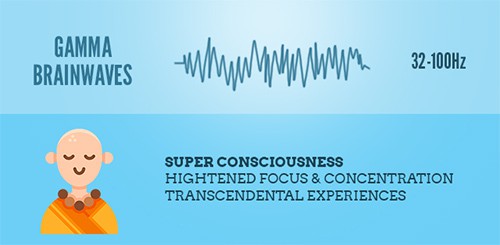
These brainwaves were unknown for a long time because the analog EEG could not detect brainwaves higher than 20Hz. With the advent of digital EEGs, gamma brainwaves were discovered.
People with high gamma brainwaves show the following characteristics:
- High IQ.
- Increased intelligence.
- Increased memory recall.
- Increased sensory perception.
- High degree of focus and concentration.
- High degree of self-control.
- High compassion.
- Increased happiness and feelings of joy.
In the case of gamma, it is observed that neurons in different regions of the brain fire in harmony. A natural way to generate gamma brainwaves is to meditate. Meditation especially on love and compassion can help in generating gamma brainwaves.
Gamma brainwaves have been extensively studied on Buddhist monks (using fMRI imagery), and it was found that the monks were able to achieve this state in a short burst of time, and this was demonstrated with visuals on the display monitors.
Not only that, but the monks were able to enter and leave these states at will. This indicated their laser-like focus and ability to generate compassion at will and with ease. Even when they were not meditating, their brainwaves exhibited characteristics of gamma waves.
All of us generate gamma brainwaves, but for regular people, this lasts only for a fraction of a second, whereas, in the case of experienced meditators, it goes on for almost a full minute.
Also, the low production of gamma brainwaves is linked to lower mental processing, poor memory, and learning difficulties.
Hack Your Brain To Beat Stress and Anxiety
Modern-day lifestyle is hectic, chaotic, full of uncertainty, and high expectations. It’s an unfortunate reality that most people have accepted stress and anxiety as something normal.
This is not a very healthy way of living. If you are suffering from anxiety, you should accept the fact that it’s unhealthy, that you deserve to live an anxiety-free life, and that you have to do something about it.
From the above discussion, it is evident that anyone suffering from anxiety and depression is spending most of their time in a high beta state. So the idea is to hack our brain and transition from high beta to either low beta or theta.
So how do we do it?
One way is to take prescription medications or recreational drugs. However, great caution must be exercised if you’re going down this route. And this must be done in consultation and under the supervision of a certified medical practitioner.
Also, do consider the possibility of some gut-wrenching and life-threatening side effects.
Another way is to practice mindfulness and meditation. We have lots of resources on this blog to get you started with meditation and mindfulness. However, don’t expect an immediate result. You have to train your mind sufficiently before you see any substantial result.
The idea is to form a daily meditation (10 – 20 minutes is good enough for beginners) routine and stick to it.
Eventually, you will start noticing a great deal of change in your mood as your brainwaves transition from high frequency to lower frequencies. Even a change from high beta to the low beta will completely transform your life.
Some of the expert meditators who have been practicing meditation for years easily transition from lower beta to alpha and theta states. In these states, their mind slows down giving a very calming feeling.
You must have often heard the phrase ‘slow down’. What that basically means is that you slow down your mind by ‘taking it easy’. When you constantly operate under stress you generate high-frequency beta brainwaves, and that in turn generates anxiety within you.
With the regular practice of meditation, you will learn to ‘slow down’ your mind. When you perform each action with full consciousness, there’s no way any amount of stress or anxiety can creep inside of you.
Slowly with time, you will start noticing how your mind is becoming calm and relaxed. We have lots of resources on this blog to help you get started with mindfulness and meditation. There’s no need to go to a ‘guru’ or expensive retreats.
Meditation can be practiced in many ways (body scan, walking, loving-kindness, mantra), and there’s absolutely no dogma attached to it. You can start practicing meditation from the comfort of your home.
Final Thoughts
Meditation not only helps in relieving anxiety but also helps in developing resilience (1). Dalia Lama has been actively involved in studying the effect of meditation on the brain and has been encouraging Tibetan Buddhist monks to participate in such studies.
It has been scientifically proven that meditation leads to an increase in the gray matter in the frontal area of the brain (2).
Today, science has reached such a stage where we can measure what is going on inside the brain and train our brain using advanced techniques such as Biofeedback and Neurofeedback. We can see the progress we are making in meditation regularly.
If you have any queries or doubts, please feel free to post questions in the comments section, and I will try and answer them as soon as possible.
Take care and have a nice day.



